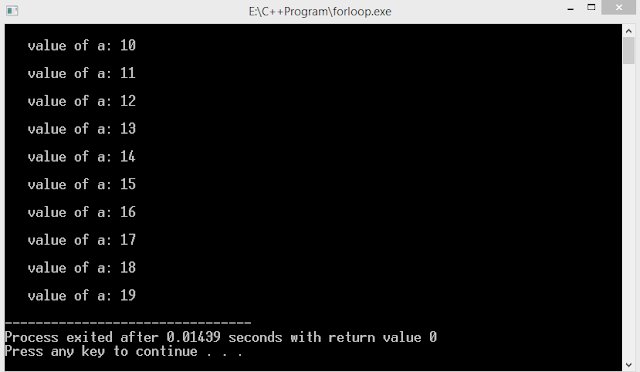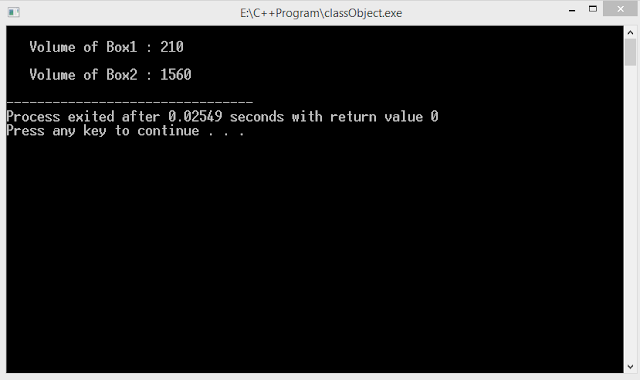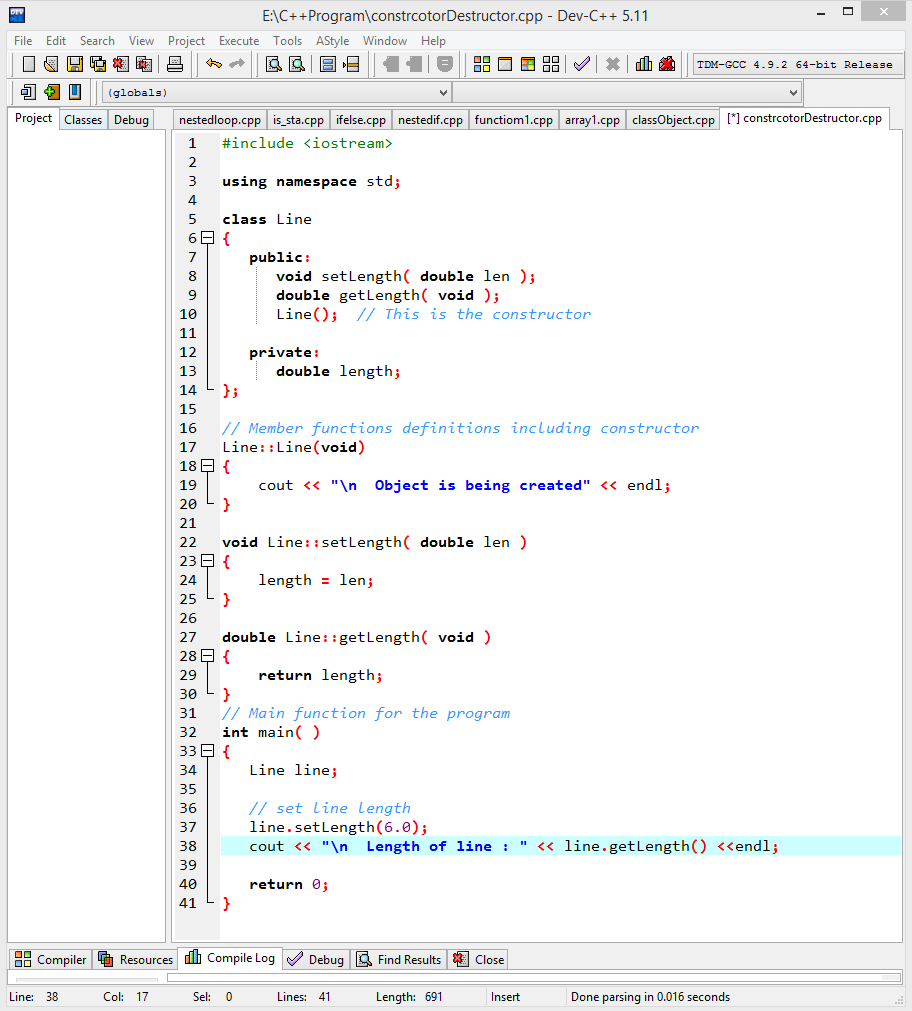C++ is a middle-level
programming language developed by Bjarne Stroustrup starting in 1979 at Bell
Labs. C++ runs on a variety of platforms, such as Windows, Mac OS, and the
various versions of UNIX.
Object-Oriented Programming
C++ fully supports
object-oriented programming, including the four pillars of object-oriented
development:
- Encapsulation
- Data hiding
- Inheritance
- Polymorphism
When we consider a C++
program, it can be defined as a collection of objects that communicate via
invoking each other's methods. Let us now briefly look into what do class,
object, methods and Instance variables mean.
- Object - Objects have states and behaviors. Example: A dog has states - color, name, breed as well as behaviors - wagging, barking, eating. An object is an instance of a class.
- Class - A class can be defined as a template/blueprint that describes the behaviors/states that object of its type support.
- Methods - A method is basically a behavior. A class can contain many methods. It is in methods where the logics are written, data is manipulated and all the actions are executed.
- Instance Variables - Each object has its unique set of instance variables. An object's state is created by the values assigned to these instance variables.
C++ Program Structure:
#include <iostream>
using namespace std;
// main() is where program execution begins.
int main()
{
cout << "Welcome Sandeep"; // prints Hello World
return 0;
}
{
cout << "Welcome Sandeep"; // prints Hello World
return 0;
}
Let us look various
parts of the above program:
- The C++ language defines several headers, which contain information that is either necessary or useful to your program. For this program, the header <iostream> is needed.
- The line using namespace std; tells the compiler to use the std namespace. Namespaces are a relatively recent addition to C++.
- The next line // main() is where program execution begins. is a single-line comment available in C++. Single-line comments begin with // and stop at the end of the line.
- The line int main() is the main function where program execution begins.
- The next line cout << "This is my first C++ program."; causes the message "This is my first C++ program" to be displayed on the screen.
- The next line return 0; terminates main( )function and causes it to return the value 0 to the calling process.
C++ Data Types
Type
|
Typical Bit Width
|
Typical Range
|
char
|
1byte
|
-127 to 127 or 0 to
255
|
unsigned char
|
1byte
|
0 to 255
|
signed char
|
1byte
|
-127 to 127
|
int
|
4bytes
|
-2147483648 to
2147483647
|
unsigned int
|
4bytes
|
0 to 4294967295
|
signed int
|
4bytes
|
-2147483648 to
2147483647
|
short int
|
2bytes
|
-32768 to 32767
|
unsigned short int
|
Range
|
0 to 65,535
|
signed short int
|
Range
|
-32768 to 32767
|
long int
|
4bytes
|
-2,147,483,648 to
2,147,483,647
|
signed long int
|
4bytes
|
same as long int
|
unsigned long int
|
4bytes
|
0 to 4,294,967,295
|
float
|
4bytes
|
+/- 3.4e +/- 38 (~7
digits)
|
double
|
8bytes
|
+/- 1.7e +/- 308
(~15 digits)
|
long double
|
8bytes
|
+/- 1.7e +/- 308
(~15 digits)
|
wchar_t
|
2 or 4 bytes
|
1 wide character
|
C++ Keywords
The following list
shows the reserved words in C++. These reserved words may not be used as
constant or variable or any other identifier names.
asm
|
else
|
new
|
this
|
auto
|
enum
|
operator
|
throw
|
bool
|
explicit
|
private
|
true
|
break
|
export
|
protected
|
try
|
case
|
extern
|
public
|
typedef
|
catch
|
false
|
register
|
typeid
|
char
|
float
|
reinterpret_cast
|
typename
|
class
|
for
|
return
|
union
|
const
|
friend
|
short
|
unsigned
|
const_cast
|
goto
|
signed
|
using
|
continue
|
if
|
sizeof
|
virtual
|
default
|
inline
|
static
|
void
|
delete
|
int
|
static_cast
|
volatile
|
do
|
long
|
struct
|
wchar_t
|
double
|
mutable
|
switch
|
while
|
dynamic_cast
|
namespace
|
template
|
Variable
A
variable provides us with named storage that our programs can manipulate.
DataType variableName1,
variableName2,…variableNameN;
int
i; // declared but not
initialised
char c;
int i, j, k; // Multiple declaration
char c;
int i, j, k; // Multiple declaration
int
i=10; //initialization and
declaration in same step
int i=10, j=11;
int i=10, j=11;
If
a variable is declared and not initialized by default it will hold a garbage
value. Also, if a variable is once declared and if try to declare it again, we
will get a compile time error.
Loop
A
loop statement allows us to execute a statement or group of statements multiple
times and following is the general from of a loop statement in most of the
programming languages.
There are 3 type of loops in C++ language
There are 3 type of loops in C++ language
For
loop
For loop is used
to execute a set of statement repeatedly until a particular condition is
satisfied. we can say it an open ended loop. General
format is,
for(initialization; condition ;
increment/decrement)
Example
Variable initialization.( e.g int x=0; )
variable initialization ;
{
statement-block;
}
Example
while loop
while loop can be address as an entry control loop. It is completed in 3 steps.
condition( e.g while( x<=10) )
Variable increment or decrement ( x++ or x-- or x=x+2 )
Syntax
variable initialization ;
while (condition)
{
statements ;
variable increment or decrement ;
}
do while loop
In
some situations it is necessary to execute body of the loop before testing the
condition. Such situations can be handled with the help of do-while loop. do statement
evaluates the body of the loop first and at the end, the condition is checked
using while statement.
General format of do-while loop is,
do
{
....
.....
}
while(condition)
Nested for loop
We can also have nested for loop, i.e one for loop inside another for loop. Basic syntax is,
for(initialization; condition; increment/decrement)
{
for(initialization; condition; increment/decrement)
{
statement ;
}
}
Example
The Infinite Loop
A
loop becomes infinite loop if a condition never becomes false.
C++
programmers more commonly use the for(;;) construct to signify an infinite
loop.
#include
<iostream>
using namespace std;
int main ()
{
using namespace std;
int main ()
{
for(
; ; )
{
printf("This loop will run forever.\n");
}
{
printf("This loop will run forever.\n");
}
return
0;
}
Decision making in C++
Decision making is about deciding the order of execution of statements based on certain conditions or repeat a group of statements until certain specified conditions are met. C++ handles decision-making by supporting the following statements,
Simple if statement
The general form of a simple if statement is,
}
Decision making in C++
Decision making is about deciding the order of execution of statements based on certain conditions or repeat a group of statements until certain specified conditions are met. C++ handles decision-making by supporting the following statements,
Simple if statement
The general form of a simple if statement is,
if( expression
)
{
statement-inside;
}
statement-outside;
{
statement-inside;
}
statement-outside;
If
the expression is
true, then 'statement-inside' it will be executed, otherwise 'statement-inside'
is skipped and only 'statement-outside' is executed.
Example
if...else statement
The general form of a simple if...else statement is,
Example
if...else statement
The general form of a simple if...else statement is,
if( expression
)
{
statement-block1;
}
else
{
statement-block2;
}
If the 'expression' is true, the 'statement-block1' is executed, else 'statement-block1' is skipped and 'statement-block2' is executed.
Example
Nested if....else statement
The general form of a nested if...else statement is,
{
statement-block1;
}
else
{
statement-block2;
}
If the 'expression' is true, the 'statement-block1' is executed, else 'statement-block1' is skipped and 'statement-block2' is executed.
Example
The general form of a nested if...else statement is,
if( expression
)
{
if( expression1 )
{
statement-block1;
}
else
{
statement-block 2;
}
}
else
{
statement-block 3;
}
Example
{
if( expression1 )
{
statement-block1;
}
else
{
statement-block 2;
}
}
else
{
statement-block 3;
}
Example
Functions in C++
Functions are used to provide modularity to a program. Creating an application using function makes it easier to understand, edit, check errors etc.
Syntax of Function
return-type function-name (parameters)
{
// function-body
}
Functions are used to provide modularity to a program. Creating an application using function makes it easier to understand, edit, check errors etc.
Syntax of Function
return-type function-name (parameters)
{
// function-body
}
- return-type : suggests what the function will return. It can be int, char, some pointer or even a class object. There can be functions which does not return anything, they are mentioned with void.
- Function Name : is the name of the function, using the function name it is called.
- Parameters : are variables to hold values of arguments passed while function is called. A function may or may not contain parameter list.
- Function body : is he part where the code statements are written.
Call by Value
In
this calling technique we pass the values of arguments which are stored or
copied into the formal parameters of functions. Hence, the original values are
unchanged only the parameters inside function changes.
Call by Reference
In this we pass the address of the variable as arguments. In this case the formal parameter can be taken as a reference or a pointer, in both the case they will change the values of the original variable.
Example
Array
C++ provides a data structure, the array, which stores a fixed-size sequential collection of elements of the same type.
An
array is a sequence of variable that can store value of one particular data
type.
type array_name[size];
int age[5];
This array can hold 5 integer elements.
type array_name[size];
int age[5];
This array can hold 5 integer elements.
C++ Class
A class is
the collection of related data and function under a single name. A C++ program
can have any number of classes.
Class is defined in
C++ programming using keyword class followed by identifier(name of class). Body
of class is defined inside curly brackets an terminated by semicolon at the end
in similar way as structure.
class class_name
{
// some data
// some functions
};
{
// some data
// some functions
};
C++ Object
When class
is defined, only specification for the object is defined. Object has same
relationship to class as variable has with the data type. Objects can be
defined in similary way as structure is defined.
class_name variable name;
Data
members and member functions can be accessed in similar way the member of
structure is accessed using member operator(.).
For the
class and object defined above, func1() for object obj2 can
be called using code:
obj2.func1();
Similary,
the data member can be accessed as:
object_name.data_memeber;
Constructor
Constructors are the
special type of member function that initialises the object automatically when
it is created .
Constructor has same
name as that of class and it does not have any return type.
class A
{
int x;
public:
A(); //Constructor
};
{
int x;
public:
A(); //Constructor
};
Destructor
Destructor is a
special class function which destroys the object as soon as the scope of object
ends. The destructor is called automatically by the compiler when the object
goes out of scope.
The syntax for destructor
is same as that for the constructor, the class name is used for the name of
destructor, with a tilde ~ sign as prefix to
it.
class A
{
public:
~A();
};
{
public:
~A();
};
File Handling concept in C++ language is used for store a data
permanently in computer. Using file handling we can store our data in Secondary
memory (Hard disk).
Why use File Handling
- For permanet storage.
- The transfer of input - data or output - data from one computer to another can be easily done by using files.
- For read and write from a file you need another standard C++ library called fstream, which defines three new data types:
Datatype
|
Description
|
ofstream
|
This is
used to create a file and write data on files
|
ifstream
|
This is
used to read data from files
|
fstream
|
This is
used to both read and write data from/to files
|
Defining and
Opening a File
The function open() can be used to open multiple files
that use the same stream object.
file-stream-class
stream-object;
stream-object.open("filename");
stream-object.open("filename");
Closing a File
A file must be close after completion of all operation
related to file. For closing file we needclose() function.
outfile.close();
put() and get()
function
The function put() write a single character to the
associated stream. Similarly, the function get() reads a single character from
the associated stream.
read() and write()
function
These function take two arguments. The first is the
address of the variable V , and the second is the length of that variable in
bytes. The address of variable must be cast to type char * (i.e pointer to
character type).

























